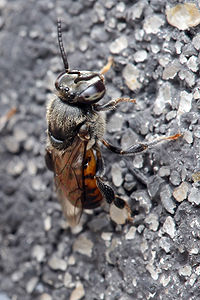
Photo from wikipedia
Honey bee colonies require adequate pollen for maintenance and growth. Pollens vary in nutritional value, and a balanced diet is achieved by mixing pollens with complementary essential nutrients. We tested… Click to show full abstract
Honey bee colonies require adequate pollen for maintenance and growth. Pollens vary in nutritional value, and a balanced diet is achieved by mixing pollens with complementary essential nutrients. We tested subjective evaluation of pollens by foragers in colonies deprived of one of two essential fatty acids (eFAs), alpha-linolenic acid (omega-3) or linoleic acid (omega-6). We used four pollens, two rich in omega-3 and two rich in omega-6. A colony in an observation hive was allowed to forage for 2–5 days on a single pollen source. The following day, we repeatedly presented one of three pollens: the same pollen that the bees had been collecting the previous days, a novel pollen that was similarly deficient in omega-3 or omega-6, and a novel pollen that complemented their eFA deficiency. We measured the rate of waggle dances, which reflects on the strength of recruitment effort, of foragers returning to the observation hive from each of the pollens. Dance rates did not differ between the four pollens, but they were the highest to the “complementary” pollen and the lowest to the “same” pollen. Furthermore, this effect was greater for pollen combinations with greater eFA disparity between the same and the complementary pollens. Our findings support the ability of bees to balance colony eFA intake. Conditioning of the proboscis extension response (PER) tests showed that pollen foragers discriminated well between the four pollen odors, but the mechanisms by which bees assess pollen eFA composition remain to be elucidated. Differential dancing would recruit foragers to pollens that balance colony nutritional needs.Significance statementHoney bee foragers use dance communication to recruit nestmates to floral sources, with higher dance rates representing greater subjective evaluation of the floral source by the dancer. We fed colonies for a few days with a single pollen source, which was poor in one eFA (omega-3 or omega-6) and rich in the other. We then recorded the dances of foragers that collected each of the three pollens: the same pollen that the bees had been collecting the previous days, a novel pollen that was similarly deficient in omega-3 or omega-6, and a novel pollen that complemented their eFA deficiency. Dance rates were the highest to the “complementary” pollen and the lowest to the “same” pollen, showing that a colony could differentially recruit foragers to pollens that balance its nutritional needs.
Journal Title: Behavioral Ecology and Sociobiology
Year Published: 2017
Link to full text (if available)
Share on Social Media: Sign Up to like & get
recommendations!